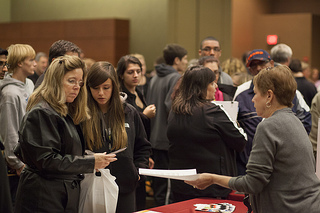USC Responds To Issue Of Low-Income Schools Receiving Fewer Visits

As elite colleges continue neglecting low-income public high schools, the University of Southern California is trying to ensure that high school students from a variety of backgrounds have access to higher education.
“I believe we send out more recruiters than any school in the country,” Timothy Brunold, USC’s Dean of Admission said. “We think visiting high schools is the best and most valuable way to reach potential students.”
It appears not all colleges and universities share this sentiment though; according to a survey conducted by the Los Angeles Times more college recruiters visited private and affluent high schools last fall than heavily low-income, minority schools.
Among the Southern California high schools surveyed between August and November, schools in affluent communities received startlingly more college recruiters than those in lower-income communities. La Canada High School hosted 127 visits, Palisades Charter hosted 133 visits and Marlborough School hosted 102 visits.
By contrast, when surveyed, the less affluent Pasadena High School reported only 20 visits over the fall semester, Jefferson High in South LA received four visits, Hoover High in Glendale recieved 15 visits and Belmont High near downtown Los Angeles received about 25 visits, according to the LA Times.
READ MORE: The Many Faces Of USC: Watts
As shocking as these results are, Brunold said they aren’t too surprising considering some factors that can prevent colleges from reaching certain high schools.
“Many times at under-resourced schools, there is no school counselor to reach out to colleges, so some colleges have a problem finding the right person to talk to,” Brunold said. “A lot of colleges won’t attend a school if they can’t get ahold of anyone.”
Dealing with just that issue, Jefferson High Principal Michael Taft explained to the LA Times how his school lost funding for a full-time counselor who once arranged for the visits and who could encourage recruiters to overcome negative images of low-income, heavily minority public schools.
"Underserved communities have trouble getting resources and access to things like that," Taft said.
Although this may be a potential roadblock for some universities, Brunold says his team at admissions works aggressively to reach schools and students.
"It can become a self-perpetuating cycle if colleges continue to attend the same schools each year,” he said. “But, I think at USC we try to debunk that trend.”
READ MORE: Gov. Brown's New Funding Plan Means Big Changes For LAUSD
"No one can visit every high school in the country, but here at USC were work aggressively to reach the most high schools than any other university,” Brunold said. Just this fall USC sent out recruiters to 390 high schools, 63 percent of which were in lower-income communities. With about 30,000 high schools in the country, USC visits about 2,000 of them including schools from all 50 states, according to Brunold.
Although each university has their own method of selecting which schools to visit, Brunold explained that his team devices a list, "mostly through feedback from management and admission advisers."
Brunold also mentioned that recruiters are more likely to visit schools that are nearby because it's been proven that students are more likely to attend schools closer to home.
According to a survey conducted by The Chronicle of Higher Education, 20 percent of college freshman's surveyed said that being close to home was a very important factor in their college choice. This trend is rising slowly from 16 percent, four decades ago.
When scouting for potential transfer students, Brunold said that the process remains very similar.
“The recruitment process for community colleges is a fairly similar process, but USC is atypical again because it enrolls more transfer students than any private university—a majority of which are from California,” he said
READ MORE: UCLA, UC Berkeley Travel Far-And-Wide To Diversify Applicants
Recalling his journey to USC, theater major Andrew Buenrostro doesn't recall anyone from USC stopping by his high school in Union City, Calif. or his community college in Hayward, Calif. to recruit students, but he says that didn't stop him from wanting to be part of the Trojan family.
"I researched which school's were the best for my major and USC had a top ranking drama school, so I—in essence—recruited USC," Buenrostro said.
When considering the recent LA Times article, Buenrostro shared his feeling about the recruitment issue.
"I think private universities will go out of their way and try to find the best [student] no matter where they are; whereas public universities will try to get whoever they know will be able to pay their tuition fees—someone they will not have to give money to," Buenrostro said.
Having experienced a similar recruitment process, business major Emilio Nunez shared his sentiments.
"I've always know that USC was a business place, but no one actual reached out to me and said, 'Hey you should come to USC!'" Nunez said. "You just had to do your own research about the [admission] process."
Nunez also mentioned he relied greatly on help from his community college counselor, who kept him on track through the school's articulation agreement with USC.
Although visits from college recruiters do not determine if a student will be accepted into the university, they can be a catapult for low-income students to learn about education opportunities that exist beyond their neighborhoods.
“It’s the time students can meet with someone one-on-one and ask the questions they need to,” Brunold said. “It’s more personal.”



